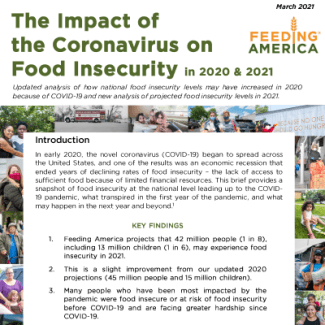When the COVID-19 pandemic began in early 2020, the public health emergency caused communities to close, unemployment to soar, and, for many, anxiety about paying for and accessing enough food to mount. Leveraging our deep understanding of the relationship between food insecurity and drivers like unemployment and poverty, Feeding America generated projections of how food insecurity may have changed during the first two years of the pandemic.
Note: At this time, our latest set of projections are no longer considered current. For our latest historical estimates of food insecurity at the local level, check out Map the Meal Gap. Below is the archive of briefs and projections released and revised between March 2020 and March 2021.
Archived Briefs/Projections
The Impact of the Coronavirus on National Food Insecurity in 2020 & 2021 (released March 9, 2021)

This brief includes updated 2020 projections and new 2021 projections at the national level for the overall population and for children. In addition, for the first time we included projections by race (for Black and white individuals), by geography (rural and urban), and for very low food security.
The Impact of the Coronavirus on Local Food Insecurity in 2020 & 2021 (released March 31, 2021)

This brief includes updated 2020 projections and new 2021 projections at the local level, including counties, congressional districts, and states, for the overall population and for children. In addition, for the first time we include projections for very low food security.
Updated 2020 Food Insecurity Projections (Released October 2020)
2020 Food Insecurity Projections (Released between March and May 2020)

